Agave plants are a popular choice for gardeners and homeowners alike, as they are low-maintenance and can add a unique touch to any landscape. However, one common issue that may arise is when the leaves of the agave plant begin to turn brown.
This can be concerning for those who are not familiar with the plant, but there are several reasons why this may occur.
Understanding agave plants is key to identifying the cause of brown leaves. Agave plants are succulents that store water in their leaves, making them drought-tolerant and able to survive in arid environments. However, they are not immune to damage and can be affected by a variety of factors that may cause the leaves to turn brown.
These factors can include overwatering, fungal infections, pest infestations, and exposure to extreme temperatures or sunlight.
While there are several potential causes for agave leaves turning brown, there are also preventive measures and treatment options available to help maintain the health of the plant.
It is important to identify the root cause of the issue to determine the best course of action. In this article, we will explore the common causes of brown agave leaves, how to prevent the issue from occurring, and treatment options for those already experiencing the problem.
Key Takeaways
- Understanding agave plants is key to identifying the cause of brown leaves.
- Common causes of brown agave leaves include overwatering, fungal infections, pest infestations, and exposure to extreme temperatures or sunlight.
- Preventive measures and treatment options are available to help maintain the health of the plant.
Don’t miss out on these other popular picks:
- African Violet Flowers Turning Brown
- African Milk Tree Turning Brown:
- Why Does My Pothos Have Brown Spots?
Understanding Agave
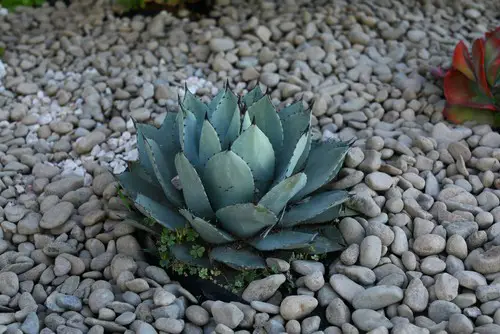
Agave is a succulent plant native to Mexico and is commonly used in gardens worldwide. It is a hardy plant that requires minimal maintenance, making it a popular choice for gardeners. The plant has thick, fleshy leaves that store water, helping it survive in dry conditions.
Agave is also known for its long stalks that sprout from the center of the plant and produce flowers.
Agave plants have a unique life cycle. They grow slowly and take several years to reach maturity. Once mature, they produce a tall stalk that can reach up to 30 feet in height. The stalk produces flowers, and after pollination, the plant dies. However, before the plant dies, it produces several offsets or pups that can be replanted to grow new agave plants.
One of the most common issues with agave plants is brown leaves. Brown leaves can be a sign of several problems, including overwatering, fungal infections, pests, or too much sun exposure.
Overwatering is the most common cause of brown leaves in agave plants. The soil should be allowed to dry out between watering to prevent waterlogging, which can lead to root rot and brown leaves.
Another cause of brown leaves in agave plants is fungal infections. Fungal infections can cause brown spots on the leaves, which can spread quickly if not treated promptly. Pests, such as mites and mealybugs, can also cause brown leaves in agave plants. These pests feed on the sap of the plant, which can cause the leaves to turn brown and wither.
To prevent brown leaves in agave plants, it is essential to provide them with the right growing conditions. Agave plants require well-draining soil and should be watered sparingly.
They also need plenty of sunlight but should be protected from extreme heat and cold. Regular inspection for pests and fungal infections can also help prevent brown leaves in agave plants.
Overall, understanding agave plants’ unique life cycle and growing requirements can help gardeners maintain healthy and vibrant plants.
Agave Leaves Turning Brown – 4 Common Problems
Agave plants are known for their striking appearance and low maintenance requirements. However, if you notice your agave leaves turning brown, it may be a sign of an underlying issue. Here are some common causes of browning in agave plants.
1. Watering Issues

Overwatering is one of the most common reasons for agave leaves turning brown. When the soil is saturated with water, it can lead to root rot and other fungal infections. On the other hand, underwatering can cause the leaves to dry out and turn brown. It is important to strike a balance between the two and ensure that the soil is well-draining.
2. Sunlight Exposure
Agave plants thrive in direct sunlight, but too much of it can cause the leaves to turn brown. If your agave plant is exposed to direct sunlight for extended periods, it can lead to sunburn and browning. It is recommended to provide some shade during the hottest parts of the day.
3. Temperature and Humidity Factors
Agave plants are adapted to hot and dry environments. If the temperature drops below 50°F (10°C), it can cause the leaves to turn brown. Similarly, high humidity can cause fungal infections and browning. It is important to maintain a temperature range between 50°F to 85°F (10°C to 29°C) and keep the humidity levels low.
4. Nutrient Deficiency
A lack of nutrients can also cause agave leaves to turn brown. Agave plants require a well-balanced fertilizer with a higher nitrogen content. A lack of nitrogen can cause the leaves to turn yellow and brown. It is recommended to fertilize your agave plant once a month during the growing season.
By addressing these common causes of browning in agave plants, you can help ensure that your plant remains healthy and vibrant.
Agave Diseases
Agave plants are susceptible to various diseases that can cause their leaves to turn brown. The most common diseases that affect agave plants are fungal and bacterial infections, as well as root and crown rot. Understanding the symptoms and causes of these diseases can help you take the necessary steps to prevent them from affecting your agave plant.
1. Fungal Diseases
Fungal infections are a common cause of brown spots on agave leaves. These infections can be caused by various types of fungi, such as Fusarium, Phyllosticta, and Colletotrichum. Symptoms of fungal infections include brown or gray spots on the leaves, which can spread quickly if not treated.
To prevent fungal infections, it is important to avoid overwatering your agave plant. Fungi thrive in damp conditions, so make sure your plant is not sitting in water. You can also use a fungicide to treat the infection, but be sure to follow the instructions carefully to avoid damaging your plant.
2. Bacterial Diseases
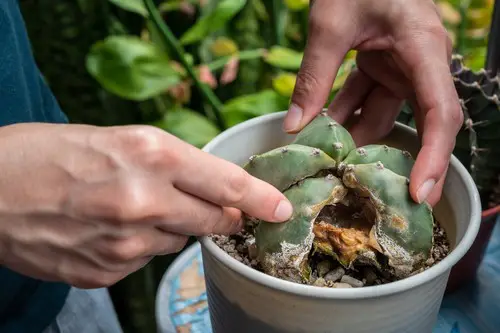
Bacterial infections can also cause brown spots on agave leaves. These infections are caused by bacteria such as Xanthomonas and Pseudomonas. Symptoms of bacterial infections include black lesions on the leaves, which can spread quickly if not treated.
To prevent bacterial infections, it is important to keep your agave plant clean and free from debris. You can also use a bacterial spray to treat the infection, but be sure to follow the instructions carefully to avoid damaging your plant.
3. Root and Crown Rot
Root and crown rot are caused by fungi that attack the roots and base of the plant. Symptoms of root and crown rot include wilting and yellowing of the leaves, as well as blackening and softening of the stem.
To prevent root and crown rot, it is important to avoid overwatering your agave plant and to ensure that it is planted in well-draining soil. If your plant is already infected, you can try to treat it by cutting away the infected parts and applying a fungicide.
Pest Infestation
Agave plants are susceptible to pest infestations, which can cause the leaves to turn brown. Here are some common pests that can infest agave plants:
1. Agave Snout Weevil
The agave snout weevil is a common pest that can cause significant damage to agave plants. These weevils lay their eggs in the plant’s crown, and the larvae feed on the plant tissue, causing the leaves to turn brown and wilt. The adult weevils can also cause damage by chewing on the leaves and stem.
To prevent infestations, it’s important to inspect new plants for signs of weevils before bringing them into your garden. You can also use sticky traps to catch adult weevils, and apply insecticides to control the larvae.
2. Mealybugs
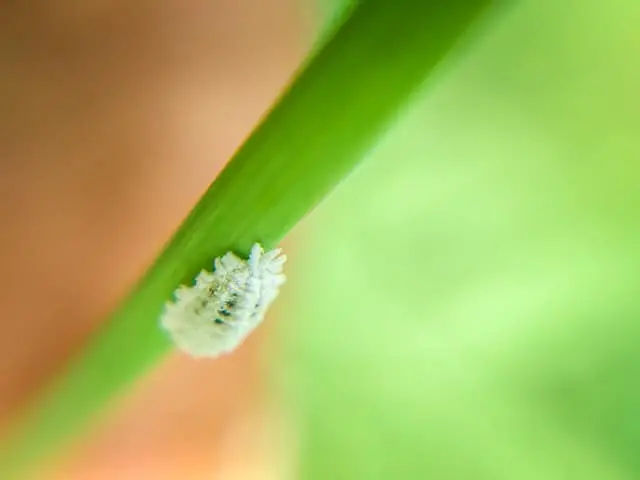
Mealybugs are small, white, cottony insects that feed on the sap of agave plants. They can cause the leaves to turn brown and wilt, and can also attract ants and other pests.
To control mealybugs, you can spray the plant with a solution of water and dish soap, or use insecticidal soap. You can also introduce natural predators, such as ladybugs or lacewings, to help control the infestation.
3. Aphids
Aphids are small, soft-bodied insects that feed on the sap of agave plants. They can cause the leaves to turn brown and wilt, and can also transmit plant viruses.
To control aphids, you can spray the plant with a solution of water and dish soap, or use insecticidal soap. You can also introduce natural predators, such as ladybugs or lacewings, to help control the infestation.
Preventive Measures
Agave leaves turning brown can be prevented by implementing certain preventive measures. Proper soil and drainage, pruning and sunlight management, nutrient management, and irrigation practices are some of the important factors that can help prevent agave leaves from turning brown.
1. Proper Soil and Drainage
Agaves need well-draining soil to prevent root rot and other diseases caused by overwatering. The soil should be a mixture of sand, gravel, and organic matter that allows water to drain quickly. It is important to use sterilized soil to prevent the spread of disease and pests.
2. Pruning and Sunlight Management
Pruning is necessary to remove dead or yellow leaves and to control the size of the plant. Agaves need full sun to thrive, but excessive sunlight can cause the leaves to turn brown. Therefore, it is important to provide some shade during the hottest part of the day to prevent sunburn.
3. Nutrient Management
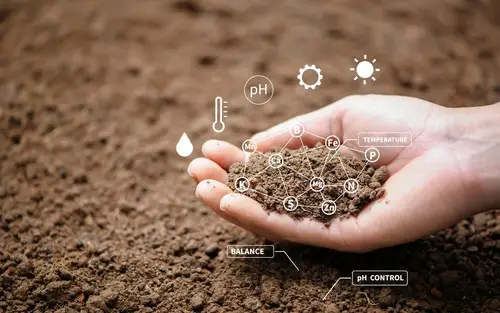
Agaves do not require a lot of fertilizer, but they do need some nutrients to grow healthy. A slow-release fertilizer that contains nitrogen, phosphorus, and potassium can be applied once a year during the growing season. Over-fertilizing can cause the leaves to turn brown, so it is important to follow the instructions on the package.
4. Irrigation Practices
Agaves are drought-tolerant plants that do not require a lot of water. Overwatering can cause the leaves to turn brown and mushy. It is important to water the plant deeply but infrequently to allow the soil to dry out between watering. A well-mulched soil can help retain moisture and prevent evaporation.
Treatment Options
If you notice brown spots on your agave leaves, there are several treatment options available. The following sub-sections detail some of the most effective methods for treating brown spots on agave leaves.
1. Using Fungicides
One of the most common causes of brown spots on agave leaves is anthracnose fungus. If you suspect that your plant has a fungal infection, you can use a fungicide to treat it.
Thiophanate methyl is a common fungicide that can be used to control anthracnose fungus. To use this product, mix it with water according to the manufacturer’s instructions and apply it to the affected leaves. Repeat this process every two weeks until the fungus is under control.
2. Using Insecticides
Another potential cause of brown spots on agave leaves is insect infestation. If you notice small holes or bite marks on your leaves, your plant may be infested with insects. In this case, you can use an insecticide to control the infestation.
Neem oil is a natural insecticide that is effective against a wide range of pests. Mix the neem oil with water according to the manufacturer’s instructions and apply it to the affected leaves. Repeat this process every two weeks until the infestation is under control.
3. Natural Remedies
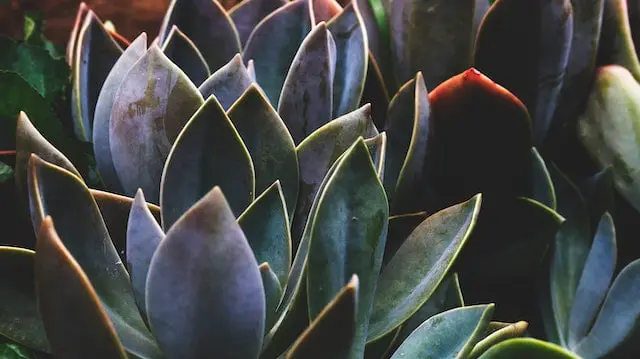
If you prefer to use natural remedies to treat brown spots on agave leaves, there are several options available. One effective natural remedy is a mixture of equal parts water and bleach.
Apply this mixture to the affected leaves using a spray bottle. Be sure to rinse the leaves thoroughly with water after applying the mixture. Another natural remedy is to simply remove the affected leaves from the plant. This can help prevent the spread of the infection or infestation.
Overall, there are several effective treatment options available for brown spots on agave leaves. Whether you choose to use a fungicide, insecticide, or natural remedy, be sure to follow the manufacturer’s instructions carefully to ensure the best possible results.
Frequently Asked Questions
Why are my agave leaves turning brown?
Agave leaves can turn brown due to various reasons such as overwatering, underwatering, exposure to extreme temperatures, pests, and diseases.
What causes agave leaves to turn brown?
Overwatering is one of the most common causes of brown agave leaves. When the soil doesn’t drain well enough, it becomes waterlogged, leading to root rot and brown leaves.
Exposure to extreme temperatures, especially cold temperatures, can also cause the leaves to turn brown. Pests such as spider mites, mealybugs, and scale insects can also damage the leaves, causing them to turn brown.
How do I prevent my agave leaves from turning brown?
To prevent agave leaves from turning brown, it is essential to ensure that the plant is getting the right amount of water. Agave plants prefer well-draining soil, so it is crucial to avoid overwatering.
It is also essential to protect the plant from extreme temperatures by providing shade during hot weather and covering it during cold weather. Regular inspection for pests and diseases is also essential for preventing brown leaves.
What is the best way to treat brown agave leaves?
The best way to treat brown agave leaves is to remove them from the plant. Prune the affected leaves using a sharp, clean pair of scissors or pruning shears.
After pruning, make sure to sterilize the tools to prevent the spread of diseases. If the brown leaves are due to pests or diseases, it is essential to treat the plant with the appropriate insecticide or fungicide.
Can brown agave leaves be saved?
If the brown leaves are due to overwatering, it may be possible to save the plant by improving the drainage and reducing the amount of water it receives.
However, if the brown leaves are due to pests or diseases, it may be challenging to save the plant. In such cases, it is best to remove the affected leaves and treat the plant with the appropriate insecticide or fungicide.
Are brown agave leaves a sign of a larger problem?
Brown agave leaves can be a sign of a larger problem such as root rot, pests, or diseases. It is essential to inspect the plant thoroughly to determine the cause of the brown leaves. If the problem is left untreated, it can lead to the death of the plant.

Hey, I’m Lisa and I’ve been an avid gardener for over 30 years. I love writing, talking and living in the garden! Feel free to connect with me on my socials below


